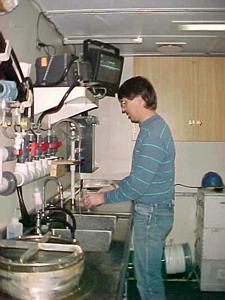5 March, 2000
Still heading to the Drake Passage and on to Palmer Station in
Antarctica. The first data collection has begun. Chief Scientist,
Dr. Dave DeMasters collects a water sample each hour. The sample is
filtered for plankton and ice, and then analyzed. The latitude and
longitude, and water temperature of each collection site is logged.
The water is analyzed for nitrates and silicates. The nitrates would
come from fecal material an decaying organic matter. The silicates
come from the "skeletal" structure of diatoms, a microscopic organism.
The results from the cruse in November indicated that in the warmer
waters, the nutrients at the surface were used fairly quickly by
organisms there and the remaining nutrients sank to the benthos (the
bottom) where they remained. In the colder waters the unused
nutrients also sink to the benthos but wind mixing of the layers of
water causing an upwelling from the benthos reintroduced the
nutrients to the upper layers in the water column keeping the amounts
there at a higher level. Dave is collecting more data this March to
determine the nutrient levels at this time of year.

Dr. Dave DeMasters collecting a water sample in the lab for nutrient analysis.
Contact the TEA in the field at
.
If you cannot connect through your browser, copy the
TEA's e-mail address in the "To:" line of
your favorite e-mail package.
|
